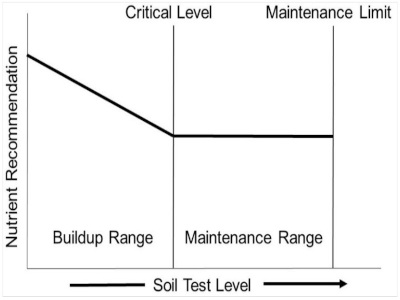By Michael Staton and Kurt Steinke
The keys to maximizing the economic returns from phosphorus (P) and potassium (K) fertilizer applications are a comprehensive soil testing program including a current soil test, and maintaining phosphorus and potassium soil test levels above their respective critical concentrations. The critical concentration for a given nutrient is the soil test level at which 95 to 97% of the crop’s yield potential will be reached without additional inputs of the nutrient.
The Michigan State University Extension nutrient recommendation framework for phosphorus and potassium (Figure 1) includes the build and maintain philosophy. When soil test levels are below critical, phosphorus and potassium fertilizer recommendations are higher than crop removal in order to build up nutrient levels in the soil. At soil test levels between the critical level and the maintenance limit, phosphorus and potassium fertilizer recommendations are equal to crop removal. At soil test levels greater than the maintenance limit, no additional nutrient applications are recommended.

Figure 1. MSU Extension’s phosphorus and potassium recommendation framework.
Table 1. Phosphorus and potassium critical levels and maintenance limits for soybean (based upon revised tri-state fertilizer recommendations).
Nutrient | Cation exchange capacity (meq/100 g) | *Critical level (ppm) | *Maintenance limit (ppm) |
|---|
Phosphorus | All | 20 | 40 |
Potassium | <5 | 100 | 130 |
Potassium | >5 | 120 | 170 |
*These soil test levels apply when phosphorus and potassium were extracted using the Mehlich III extraction solution and reported as Mehlich III values and not converted to Bray P1 or ammonium acetate.
Phosphorus
The soybean critical level for phosphorus is 20 parts per million (ppm) and the maintenance limit is 40 ppm. These levels assume that the soil test results are reported as Mehlich III levels not Bray P1. Most soil testing laboratories use the Mehlich III extraction solution but producers may need to request that the results are reported as Mehlich III values and not converted to Bray P1 values. The phosphorus soil test levels should be maintained between 20 and 40 ppm.
Because soybeans remove 0.8 pounds per bushel of P2O5, maintenance levels of phosphorus fertilizer are required to keep phosphorus soil test levels in this range. For a 60 bushel per acre soybean crop, this is 48 pounds per acre of actual P2O5 or about 90 pounds per acre of monoammonium phosphate (MAP) or about 100pounds per acre of diammonium phosphate (DAP).
Spring phosphorus fertilizer application is recommended over fall application, especially when soil pH levels exceed 7.4. This practice may help improve phosphorus fertilizer availability by reducing phosphorus fixation in the soil.
Potassium
For soils having cation exchange capacities (CECs) less than or equal to 5 meq/100 g, the critical level is 100 ppm and the maintenance limit is 130 ppm. For soils having CECs greater than 5 meq/100 g, the critical level is 120 ppm and the maintenance limit is 170 ppm. Again, these levels apply to soil test results reported as Mehlich III and not as ammonium acetate.
Because soybeans remove 1.15 pounds of K2O per bushel, the maintenance application rate for a 60-bushel per acre soybean crop is 69 pounds of actual K2O or 115 pounds of muriate of potash (0-0-60) per acre. When applying potassium fertilizer prior to planting soybeans, spring applications are recommended over fall applications on coarse-textured soils having CECs less than 5 meq/100 g and on organic soils to avoid leaching losses.
Maintenance phosphorus and potassium fertilizer applications can be applied biannually in corn-soybean rotations under the following conditions:
- The soil is a mineral soil.
- The soil pH is less than 7.4 (to reduce phosphorus fixation).
- The fertilizer is applied prior to planting corn.
- The application rate accounts for the phosphorus and potassium removal by both crops.
- The CEC is 5 meq/100 g or higher (to reduce potassium leaching).
The effect of various phosphorus and potassium fertilizer application methods (broadcast, deep banding, 2x2 starter and foliar) on soybean yield has been evaluated in university research trials. Broadcast applications have performed equal to or better than many other application methods when soil test levels are above the critical level. When phosphorus and potassium soil test levels are below critical levels, banded applications are more efficient than broadcast application, but broadcast applications may still be required to build-up soil test levels.
Source : msu.edu